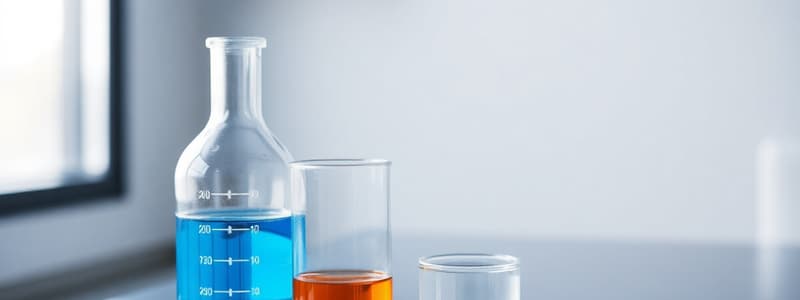Podcast
Questions and Answers
What property is primarily associated with determining the molar mass using osmotic pressure measurements?
What property is primarily associated with determining the molar mass using osmotic pressure measurements?
- Vapor pressure lowering
- Freezing point depression
- Colloidal stability
- Osmotic pressure (correct)
Which of the following factors does NOT directly affect the vapor pressure of a solution?
Which of the following factors does NOT directly affect the vapor pressure of a solution?
- Temperature of the solution
- Nature of the solute
- Volume of the solvent (correct)
- Mole fraction of the solvent
In the context of colligative properties, which calculation specifically relates to the concentration of ions in a solution?
In the context of colligative properties, which calculation specifically relates to the concentration of ions in a solution?
- Boiling point elevation
- Parts per million (ppm) (correct)
- Dilution factor
- Vapor pressure lowering
Which substance is specifically mentioned in relation to calculating vapor pressure in the problem set?
Which substance is specifically mentioned in relation to calculating vapor pressure in the problem set?
What main assumption is made when calculating colligative properties like osmotic pressure?
What main assumption is made when calculating colligative properties like osmotic pressure?
Flashcards
Colligative Properties
Colligative Properties
Properties of solutions that depend only on the number of solute particles, not their identity.
Vapor Pressure Lowering
Vapor Pressure Lowering
The lowering of vapor pressure of a solvent when a non-volatile solute is added. The vapor pressure of the solution is lower than that of the pure solvent.
Osmotic Pressure
Osmotic Pressure
The pressure that needs to be applied to a solution to prevent the inward flow of solvent across a semipermeable membrane - a measure of the solution's tendency to take in water.
Freezing Point Depression and Boiling Point Elevation
Freezing Point Depression and Boiling Point Elevation
Signup and view all the flashcards
Concentration
Concentration
Signup and view all the flashcards
Study Notes
Properties of Solutions
- Colligative Properties: Properties of a solution that depend on the concentration of solute particles, not the identity of the solute.
- Vapor Pressure Lowering: The presence of a solute lowers the vapor pressure of a solvent.
- Boiling Point Elevation: The boiling point of a solution is higher than the boiling point of the pure solvent.
- Freezing Point Depression: The freezing point of a solution is lower than the freezing point of the pure solvent.
- Osmotic Pressure: The pressure required to prevent the net flow of solvent across a semipermeable membrane.
Calculations
- Mole fraction: Expresses the ratio of the moles of one component to the total moles of all components in a mixture.
- Molality: A unit of concentration that measures the number of moles of solute per kilogram of solvent.
- Molarity: A unit of concentration that measures the number of moles of solute per liter of solution.
- Mass %: The mass of solute divided by the mass of solution, multiplied by 100%.
- PPM (parts per million): A way of expressing very low concentrations of a substance in parts of solute per million parts of solution.
Specific Examples
- Vapor Pressure of a Solution: The pressure of a solution at 50 °C of Benzene(C6H6) is 269.3mmHg. Given 1.26g of naphthalene (C10H8) in 25g of benzene, the vapor pressure of the solution at the same temperature is 261.3 mmHg.
- Pressure Osmotic: 0.1g of an enzyme dissolve in 20ml of benzene(C6H6), produces an osmotic pressure of 2.65mmHg at 25°C. The molecular weight of the enzyme is 35040g/mol.
- Water vapor pressure calculation: At 20°C, the vapor pressure of water(H2O) is 17.53 mmHg, a gas mixture containing Argon(Ar) at 20°C and 790 mmHg has 80% humidity. Calculating the dry volume at the new conditions of 25°C and 800 mmHg. The answer is 0.479L.
Contaminant in Fish
- Mercury ppm: A fish contains 0.427 ppm of mercury
- Mass of Mercury per fish: A 400g fish contains 0.171 mg of mercury.
Other Important Information
- Concentration of Substances in Sea Water: Sea water contains 1.9 x 104 ppm of Chloride (Cl-) ions and 10500 ppm of Sodium (Na+) ions are present.
- Molar Concentration: 0.549 mol/L for Chloride ion and 0.468 mol/L for Sodium ion are the molar concentrations in the sea water.
Studying That Suits You
Use AI to generate personalized quizzes and flashcards to suit your learning preferences.




